
Gear Bangers Part III
Click Here to Begin Slideshow
In the last two issues, we discussed the benefits of a dual-disc clutch and then examined some of the critical dimensions in the Tilton ST-246. This time around, we wanted to look at some of the practical dimensions – basically how big it really is and how well it fits into a bellhousing in the real world. Tilton didn’t surprise us either, as you’ll soon see. In addition, with this issue, we’ll look at the clutch options available from Tilton. Follow along for the inside scoop:
Something about which I was curious was the “stack height” of the assembly (please note, the dimensions on both assemblies were checked without using the flywheel). First, I set up a single disc 11-inch diaphragm clutch on the table and measured to the top of the pressure plate fingers. The entire package measured just over 3.0 inches. Keep in mind, this is a direct replacement clutch for an internal balance two-piece main seal Chevy.
Next, I measured the Tilton. At first glance, the clutch assembly looked much taller - but looks can be deceiving. For all intents and purposes, it’s the same height as the replacement single disc diaphragm clutch setup (FYI, the overall height of the pressure plate is a mere 2.66 inches).
So, what does this all mean? Simple. You can use a stock replacement style throw out (release) bearing with this Tilton clutch (configured for a traditional two-piece main seal Chevy). Tilton notes however, that you must use a flat base throw out bearing. Additionally, The outside diameter of the bearing face should not exceed 3.250 inches.
The next thing I wanted to double check was the fit of the complete clutch package inside a small bellhousing. For reference, I used a Quick Time RM-6022W bellhousing. This is a compact bell setup that works for both 168 and 153-tooth ring gear flywheels. The reason for checking is that I’ve witnessed clutch cover clearance issues with other clutch assemblies and other compact bellhousings (both came from the same manufacturer, but I digress). The bellhousing was assembled with a stock Chevy clutch fork along with a stock style (short) flat release bearing. The complete Tilton ST-246 was placed over the block plate (with the flywheel shimmed up in order to mimic the install on the crank flange in the car). In the photos that accompany this article, you can see the assembly. Everything fits perfectly and there’s ample clearance between the bellhousing and the clutch cover.
As pointed out earlier, there are two different options for discs – solid hub jobs and sprung hub examples. The sprung hub discs have organic facings. The bottom disc has a Marcel spring (the clutch would not release cleanly if both discs had Marcel springs). What’s a Marcel? That’s the wavy or “bowed” piece of metal that you often see sandwiched between the two halves of an organic disc. This piece of metal acts as a spring when the disk is sandwiched between the flywheel and pressure plate. When you release the clutch pedal, the Marcel springs are flattened, and gradual engagement of the clutch is achieved. Basically, the Marcel spring contributes to chatter-free clutch operation.
The other disc type available in the Tilton ST-246 is a solid (non-sprung) configuration with a cerametallic face. It does not have a Marcel spring. This type of disc provides a more precise bite point but is still very drivable on the street; plus, it will definitely hold more torque. In addition, the solid hub design can withstand more abuse than the sprung hub disc, but it creates more gearbox noise due to fact there is no sprung hub to dampen the harmonics caused by engine firings. The sprung hub organic disc setups are typically good for 850 or so lb-feet of torque; the cerametallic assemblies can hold upwards of 1250 or so lb-feet of torque.
When it comes to discs, picking the type of lining for your combination is best based upon real engine torque levels. There’s nothing to gain by using a cerametallic disc in a car with under 850 lbs-feet of torque. You’ll also lose some driveability (compared to an organic disc). The organic discs with a sprung center hub dampen engine vibration and reduce gearbox noise. But once power levels increase, a cerametallic disc is necessary. Simple as that.
We’re not quite done with the story of the Tilton ST-246. We’ll wrap it up in the next segment with a detailed look at the flywheel along with info on the installation hardware they include (there’s no need to chase after mounting hardware – it too is included). Watch for it!
In the last two issues, we discussed the benefits of a dual-disc clutch and then examined some of the critical dimensions in the Tilton ST-246. This time around, we wanted to look at some of the practical dimensions – basically how big it really is and how well it fits into a bellhousing in the real world. Tilton didn’t surprise us either, as you’ll soon see. In addition, with this issue, we’ll look at the clutch options available from Tilton. Follow along for the inside scoop:
Something about which I was curious was the “stack height” of the assembly (please note, the dimensions on both assemblies were checked without using the flywheel). First, I set up a single disc 11-inch diaphragm clutch on the table and measured to the top of the pressure plate fingers. The entire package measured just over 3.0 inches. Keep in mind, this is a direct replacement clutch for an internal balance two-piece main seal Chevy.
Next, I measured the Tilton. At first glance, the clutch assembly looked much taller - but looks can be deceiving. For all intents and purposes, it’s the same height as the replacement single disc diaphragm clutch setup (FYI, the overall height of the pressure plate is a mere 2.66 inches).
So, what does this all mean? Simple. You can use a stock replacement style throw out (release) bearing with this Tilton clutch (configured for a traditional two-piece main seal Chevy). Tilton notes however, that you must use a flat base throw out bearing. Additionally, The outside diameter of the bearing face should not exceed 3.250 inches.
The next thing I wanted to double check was the fit of the complete clutch package inside a small bellhousing. For reference, I used a Quick Time RM-6022W bellhousing. This is a compact bell setup that works for both 168 and 153-tooth ring gear flywheels. The reason for checking is that I’ve witnessed clutch cover clearance issues with other clutch assemblies and other compact bellhousings (both came from the same manufacturer, but I digress). The bellhousing was assembled with a stock Chevy clutch fork along with a stock style (short) flat release bearing. The complete Tilton ST-246 was placed over the block plate (with the flywheel shimmed up in order to mimic the install on the crank flange in the car). In the photos that accompany this article, you can see the assembly. Everything fits perfectly and there’s ample clearance between the bellhousing and the clutch cover.
As pointed out earlier, there are two different options for discs – solid hub jobs and sprung hub examples. The sprung hub discs have organic facings. The bottom disc has a Marcel spring (the clutch would not release cleanly if both discs had Marcel springs). What’s a Marcel? That’s the wavy or “bowed” piece of metal that you often see sandwiched between the two halves of an organic disc. This piece of metal acts as a spring when the disk is sandwiched between the flywheel and pressure plate. When you release the clutch pedal, the Marcel springs are flattened, and gradual engagement of the clutch is achieved. Basically, the Marcel spring contributes to chatter-free clutch operation.
The other disc type available in the Tilton ST-246 is a solid (non-sprung) configuration with a cerametallic face. It does not have a Marcel spring. This type of disc provides a more precise bite point but is still very drivable on the street; plus, it will definitely hold more torque. In addition, the solid hub design can withstand more abuse than the sprung hub disc, but it creates more gearbox noise due to fact there is no sprung hub to dampen the harmonics caused by engine firings. The sprung hub organic disc setups are typically good for 850 or so lb-feet of torque; the cerametallic assemblies can hold upwards of 1250 or so lb-feet of torque.
When it comes to discs, picking the type of lining for your combination is best based upon real engine torque levels. There’s nothing to gain by using a cerametallic disc in a car with under 850 lbs-feet of torque. You’ll also lose some driveability (compared to an organic disc). The organic discs with a sprung center hub dampen engine vibration and reduce gearbox noise. But once power levels increase, a cerametallic disc is necessary. Simple as that.
We’re not quite done with the story of the Tilton ST-246. We’ll wrap it up in the next segment with a detailed look at the flywheel along with info on the installation hardware they include (there’s no need to chase after mounting hardware – it too is included). Watch for it!



![[Gallery] Okolona Street Rods Kentuckiana V Foundation Car Show](https://www.racingjunk.com/news/wp-content/uploads/2022/04/IMG_0774-e1650040587750-376x206.jpg)
![[Gallery] Road Rats Car Show](https://www.racingjunk.com/news/wp-content/uploads/2022/05/2A-e1651770667920-376x206.jpg)

Leave a Reply